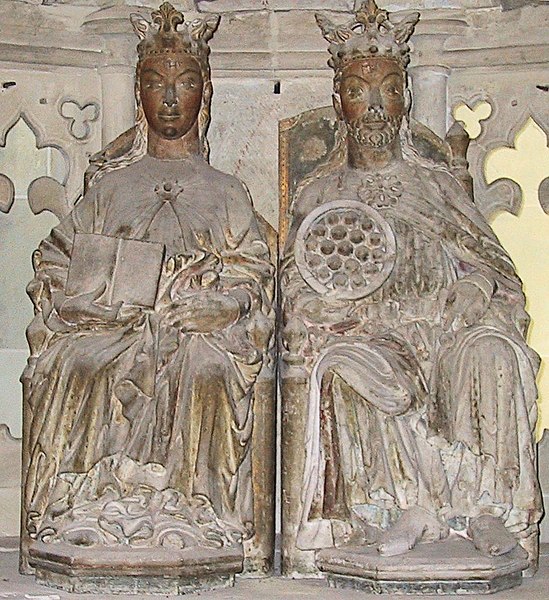
This modest exhibit of artifacts unearthed by archaeologist Rainer Kuhn at Magdeburg Cathedral sounds fascinating. Of course I was particularly interested in the remains of Queen Editha, an English woman who became the beloved of German King Otto the Great. Unlike Henry VIII's disdain for his Germanic queen, Anne of Cleves, centuries later, Otto reportedly adored Editha, daughter of Edward the Elder and sister of reigning English King Athelstan.
[Image - Sculpture of Otto I and his queen, Editha (Eadgyth) of England in Magdeburg Cathedral. Image courtesy of Wikimedia Commons]
Unfortunately, Editha, sometimes spelled Ædgyth, died between the ages of 33 to 37, so their love was rather short-lived. The article says she bore only two children but I found a genealogy record online that says she gave birth to two girls, Luitgarde Liudolfing and Richilde Richeza Liudolfing Princess of Germany, and one boy, Heinrich Liudolfing Duke of Bavaria.
After Editha's death, Otto married Adelaide, young widow of King Lothar of Italy, to save her from a forced marriage to Adalbert, son of Berengar of Ivrea, an old rival of King Lothar who had seized power upon Lothar's death. Berengar had also seized Pope John XII. In 960 CE the Pope appealed to Otto for help. Subsequently, Otto invaded Italy and defeated Berengar, seizing the iron crown of the Lombards for himself. In 962 he was proclaimed Emperor of the Romans.
Although Otto's son by Editha, Liudolfing, had been named Otto's successor in 946, Liudolfing feared for his position in the succession after his father's marriage to Adelaide produced a son as well. So, he formed an alliance with other German dukes and rose up against his father. When the Magyars invaded, Liudolfing even attempted an alliance with them which cost him much of his political support. With his alliances crumbling around him, Liudolfing surrendered formally to his father. Although his life was spared and he retained his estates, his duchy was not restored to him. The Magyars, however, fought on and in 955 Otto defeated them on the Plain of Lechfeld. Liudolfing died just two years later in 957 at the approximate age of only 27.
Editha's daughter, Luitgarde Liudolfing, ended up marrying Konrad II von Carinthia Duke of Franconia. Although she died at the tender age of 22, she did have one son, Duke Otto II von Carinthia.
Editha's second daughter, Richilde Richeza Liudolfing Princess of Germany, was the only one of her offspring that led a relatively long life. She lived to the age of 67, having married twice. But, she, too, did not have many children - only two boys.
Since almost a quarter of Editha's skeleton has survived in the lead sarcophagus that entombed it, researchers are hoping to find clues as to why the queen had relatively few children in a marriage that spanned 18 years presumably without birth control. Whatever the condition was, it appears to have been somewhat genetic as even her daughter that lived to 67 had only two children and they subsequently had only one child each in their marriages.
“We discovered the sarcophagus [of Queen Editha] with a miniature camera,” Kuhn said. “We opened it in November [2008]. Astonishingly, it was full. Full of bones, textiles and mould. All this is being analyzed in the coming months. Of the skeleton, about a quarter has survived, I would guess. As far as the textiles are concerned, it is clear that in 1510, whoever reburied her used a new cloth and put everything found in the old grave into that.”
“She died early, between the ages of 33 and 36. When we analyze her bones, we will know more about her. Was she big, small? Why did she only have two children? It’s not many for this period. How did she live? Did she suffer diseases? What did she eat?” - More: Bloomberg.com